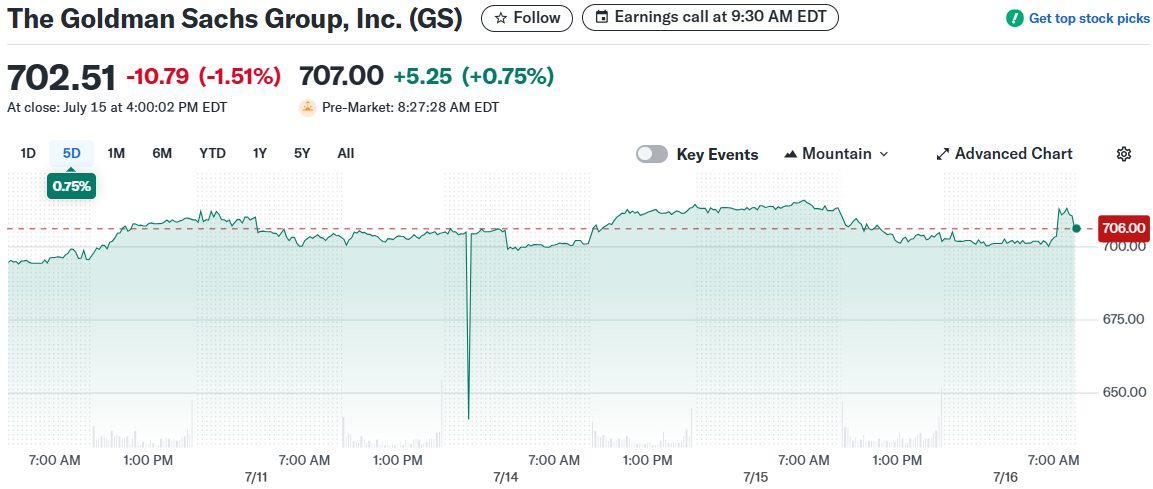TLDR
- Goldman Sachs reported Q2 earnings of $10.91 per share, beating analyst estimates of $9.69 per share
- Revenue jumped 15% year-over-year to $14.58 billion, surpassing the $13.58 billion analyst consensus
- Trading revenue surged 22% from last year, helped by market volatility from Trump’s tariffs
- Investment banking revenue rose 26%, driven by advisory fees as dealmaking momentum picked up
- Net interest income climbed 56% to $3.1 billion, above the $2.79 billion analyst forecast
Goldman Sachs delivered a knockout punch to Wall Street expectations in the second quarter. The investment banking giant reported earnings per share of $10.91, crushing analyst estimates of $9.69.
Goldman Sachs, $GS, Q2-25. Results:
📊 EPS: $10.91 🟢
💰 Revenue: $14.58B 🟢
📈 Net Income: $3.72B
🔎 Dividend raised to $4.00/share as strong Global Banking & Markets performance drove results pic.twitter.com/zbzLLzpgf0— EarningsTime (@Earnings_Time) July 16, 2025
Revenue climbed 15% year-over-year to $14.58 billion. Analysts had expected $13.58 billion, making this a clear beat across the board.
The star performer was trading revenue, which jumped 22% from the same period last year. Market volatility from President Trump’s tariffs created perfect conditions for Goldman’s traders to capitalize on client activity.
CEO David Solomon struck a cautiously optimistic tone in the earnings release. “At this time, the economy and markets are generally responding positively to the evolving policy environment,” he said.
But Solomon wasn’t getting carried away. “As developments rarely unfold in a straight line, we remain very focused on risk management,” he added.

Trading Division Hits Record Highs
Goldman’s trading prowess shone through in multiple areas. The bank posted record revenue in equities financing, which largely reflects financing to hedge funds for their own trading activities.
The firm also hit record revenue in FICC financing. This covers a range of loans Goldman makes to institutional clients across fixed income, currencies, and commodities.
Trading revenue got a boost from the firm’s lending to institutional clients. Investors continued repositioning their portfolios to adjust for Trump’s trade policies throughout the quarter.
The market turmoil that some feared would hurt banking actually helped Goldman’s bottom line. Volatility means more trading, and more trading means more revenue for the bank’s market-making operations.
Investment Banking Shows Signs of Life
Investment banking revenue rose 26% in the second quarter, driven by advisory fees. This marks a turnaround from the slower dealmaking environment in the first quarter.
Bankers and their corporate clients began feeling more comfortable about pursuing mergers and initial public offerings. The momentum that picked up in Q2 has continued into the first half of July, according to industry sources.
While the overall number of mergers and acquisitions dropped 12% industrywide during the first half of the year, the total deal value actually increased 27%. This shift favors Goldman, which focuses on larger deals around the half-billion dollar mark and above.
Several factors are driving the M&A revival. Tech companies, banks, and other firms need greater scale to navigate political uncertainty and technological upheaval.
Private-equity firms are also under pressure to unload investments they’ve been holding. They’re looking to fetch higher prices after years of sitting on deals.
Goldman’s profit jumped 22% to $3.72 billion in the quarter. This translates to the $10.91 per share figure that beat expectations.
Net interest income surged 56% to $3.1 billion. This came in above the $2.79 billion analyst consensus, showing strength across Goldman’s lending operations.
The bank’s shares were up about 1% in premarket trading following the results. They entered the day already up more than 20% since the start of this year.
Goldman’s performance mirrors what other major banks reported this earnings season. JPMorgan Chase and Citigroup also saw increases in trading revenue and investment banking on Tuesday.
JPMorgan CEO Jamie Dimon said dealmaking in the quarter “started slow but gained momentum as market sentiment improved.” This aligns with Goldman’s experience of a stronger second half of Q2.
Morgan Stanley reported higher trading revenue but said investment banking was down. This shows Goldman’s investment banking division is performing better than some competitors.
Bank stocks got a boost last month from the Federal Reserve’s annual stress test results. The test showed the nation’s biggest banks could withstand a downturn without government assistance.
Banking executives have grown more confident in the macroeconomic outlook in recent weeks. Goldman’s results suggest this confidence is translating into better business performance.
The dealmaking momentum that picked up in the second quarter has continued into July, according to bankers tracking the market.
Stay Ahead of the Market with Benzinga Pro!
Want to trade like a pro? Benzinga Pro gives you the edge you need in today's fast-paced markets. Get real-time news, exclusive insights, and powerful tools trusted by professional traders:
- Breaking market-moving stories before they hit mainstream media
- Live audio squawk for hands-free market updates
- Advanced stock scanner to spot promising trades
- Expert trade ideas and on-demand support



